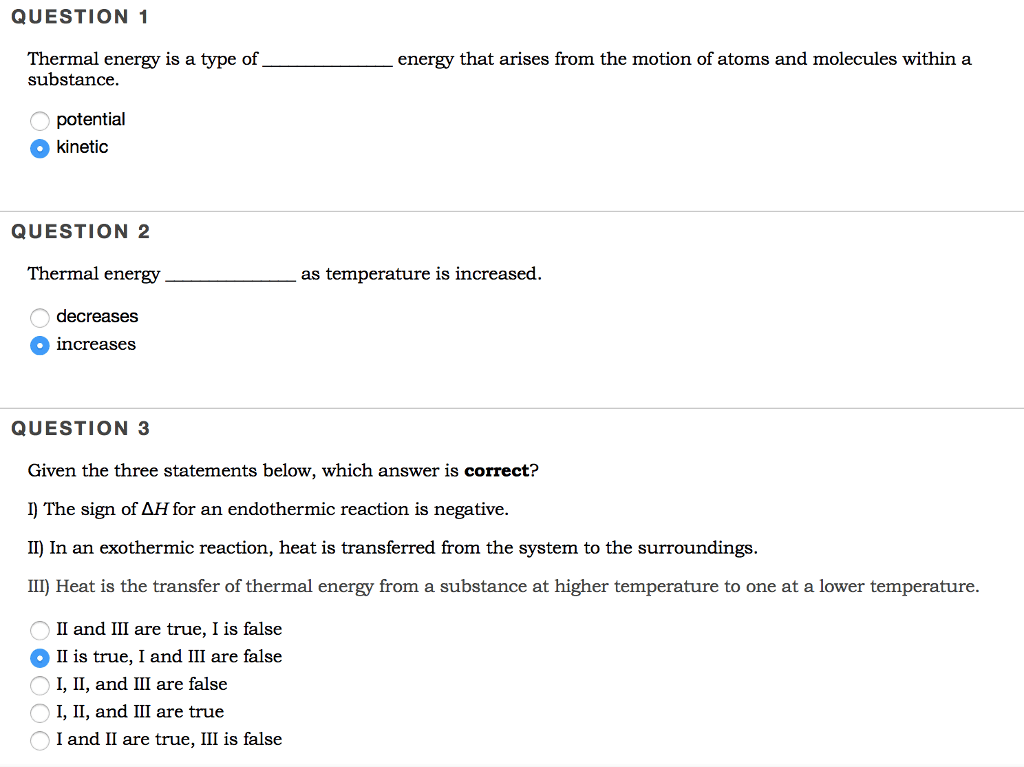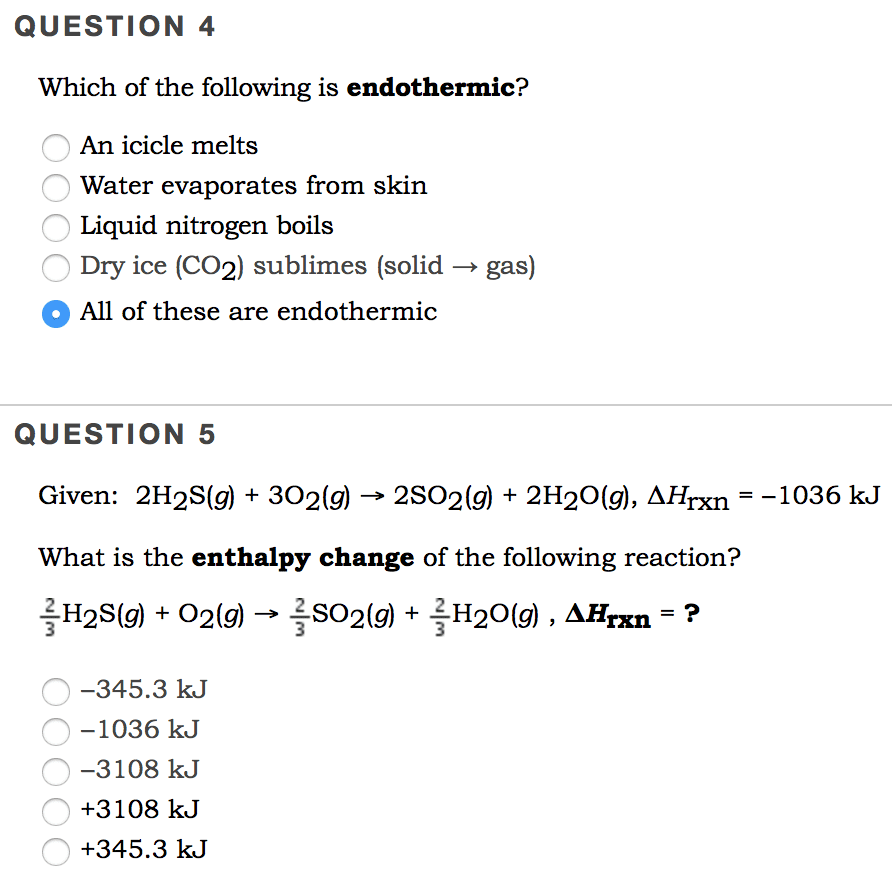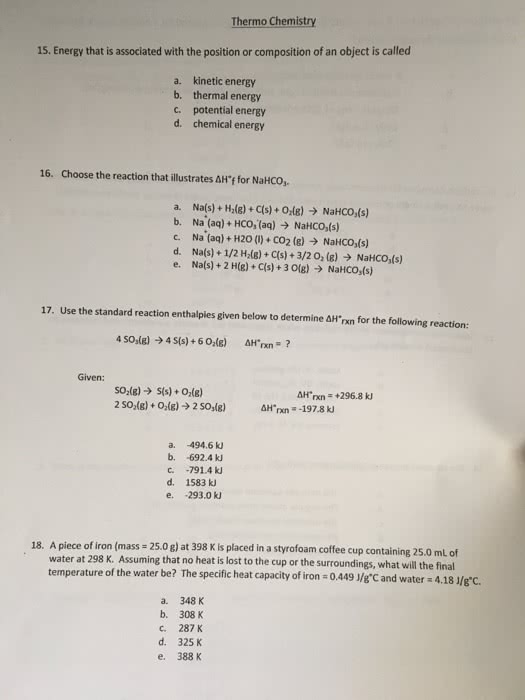CHEM 110 Chapter Notes - Chapter 6: Junkers J 1, Energy, Magnesium

Chapter 6
Nature of energy: Key Definition
- Energy is the capacity to do work (w)
o THe result of a force acting through a distance
- Heat is the transfer of energy and the flow of energy caused by a temperature difference
- Kinetic Energy is the energy associated with the motion of an object
- Thermal energy is the energy associated with the temperature of an object
o Type of kinetic energy because it arises from the motions of atoms within a
substance
- Potential Energy is the energy associated with the position or composition of an object
o Example: Energy contained in a compressed spring. When you compress a spring,
you push against the forces that tend maintain spring uncompressed
- Chemical Energy is the energy associated with relative positions of electrons and nuclei
in atoms and molecules
o Form of potential energy
- Law of conservation of energy
o States that energy can neither be created nor destroyed
o Energy can be transferred and have different forms
- Understanding the system in the equation is a good way to track energy changes
o It’s surroundinkgs are everything that can exchange energy
▪ In energy exchange, the energy is transferred between system and
surroundings
Units of Energy
- Mass is defined as m
o SI unit is KG
- Velocity as v
o SI Unit is M/s-1
- Kinetic Energy as KE
o Joule (J)
▪ One Joule is a small amount of energy
▪ 100-watt light bulb uses 3.6 * 105 J in 1 hour
• Use KJ in energy discussion
- Calorie
o Secodn commonly used unit of energy
▪ Amount of energy required to raise the temperature of 1g of water by 1C
▪ 1 cal = 4.184J
• A calorie is larger than a Joule
- Kilowatt-Hour (kWh)
o 1 kWh = 3.60 x 106
o A watt is 1 J s-1
▪ Therefore a 100-W bulb uses 100J every second or 3.6 x 105 every hour
First Law of Thermodynamics
- First law of thermodynamics is the law of energy conservation
find more resources at oneclass.com
find more resources at oneclass.com

o Total energy of the universe is constant
o Energy is neither created nor destroyed
▪ Energy is constant and does not change
o “there is no free lunch”
- Internal Energy
o Sum of the kinetic and potential energies of all the particles that compose the
system
o State of function, depends only on the state of the system not on how the system
arrived at that state
o Defined by: temperature, pressure, concentration and physical state
▪ Example: If you climb a mountain at 500m and reach the summit at
4000m, your elevation is 3500 (4000-500).
o ΔU for a chemical reaction or physical change is determined by the difference in
internal energy between the final and initial states:
• ΔrU = Ufinal − Uinitial
o On a Diagraom, verticle axis is the energy, which increases as you move pu
o If we define thermodynamics as the
reactants and products of the
reaction, then energu flows out of
system and into surrounds
▪ C + O CO2
o The energy is Identical with one
different
▪ CO2 is now the reactant and C
& O2 are the products
▪ Instead of decreasing in
energy, the system increase in
energy
▪ Internal energy is positive and energy flows into the system and out of the
surrounds
o Summary: If reactants have a higher internal energy than the products, the internal
energy is negative and energy flows out of the system
▪ If the reactants have a lower internal energy, Internal energy is positive
and energy flows into the system
- Table Summaru for Heat, Work
and Internal Energy
o System can exchange
energy with its surrounds
through heat and work
o The change of internal
energy of the system is the sum of heat transferred and the work done (ΔU = q +
w)
o Energy lost by the system, must equal the amount gained by the surrounding
(ΔUsys = −ΔUsurr)
find more resources at oneclass.com
find more resources at oneclass.com

▪ Example: A potato is shot ou of a cannon, if the burning fueld performs
855 J of work on the potato and produces 1422 J of heat, what is the ΔU
for the burning of the fuel.
• ΔU = q + w
o -1422 J – 855 J
o -2277 J
Quantifying Heat and Work
- Heat is the exchange of thermal energy between a system and its surrounds caused by a
temperature difference
o Temperature is a measure of the thermal energy within a sample of matter
o Heat is the transfer of thermal energy
o Flows from matter at high temperatures to matter at low temperatures
o The heat transfer from coffee to surrounding stops when the two reach the same
temperature (Thermal equilibrium)
▪ There is no additional net transfer of heat
o The constant of proportionality between q at ΔT is the heat capacity (C)
▪ Q = C * ΔT
• Higher the heat capacity of a system, the smaller the change in
temperature for a given amount of heat
▪ Heat Capacity of a system is defined as the quanitity of heat required to
change its temperature by 1C
• Units of heat capacity are
those of Heat (J) divided by
those of temperature (C)
▪ Heat Capacity 2 important concepts
• When you add water to a fire, the same amount of heat must now
warm more water, so temperature rises more slowly
o Heat depednds on the amount of matter being heated
• Water is more resistant to temperature change than steel
o Water has high capacity to absorb heat without undergoing
large temperature change
▪ Measure of intrinsic capacity of a substance to
absorb heat is Specific Heat Capacity
• THe amount of heat required to raise the
temperature of 1g of susbstance by 1C
▪ Also reported as Molar Heat Capacity
• The amount of heat required to raise the
temperature of 1mol of substance by 1C
• The specific heat capacity can be used to quantify the relationship
between the amount of heat added and temperature increase.
o
find more resources at oneclass.com
find more resources at oneclass.com
Document Summary
Energy is the capacity to do work (w: the result of a force acting through a distance. Heat is the transfer of energy and the flow of energy caused by a temperature difference. Kinetic energy is the energy associated with the motion of an object. Thermal energy is the energy associated with the temperature of an object: type of kinetic energy because it arises from the motions of atoms within a substance. Potential energy is the energy associated with the position or composition of an object: example: energy contained in a compressed spring. When you compress a spring, you push against the forces that tend maintain spring uncompressed. Chemical energy is the energy associated with relative positions of electrons and nuclei in atoms and molecules: form of potential energy. Law of conservation of energy: states that energy can neither be created nor destroyed, energy can be transferred and have different forms.




